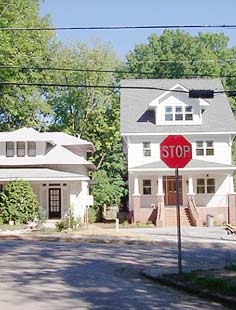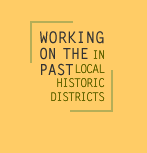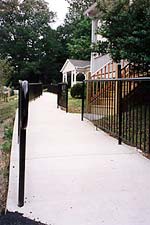
 |
||||||




Do you live in an
older or historic community that is not a designated “historic district”?
A community, such as yours, represents a unique collection of
resources, connected by time, place and feeling. Neighboring buildings
and yards, streets, trees, sidewalks, alleys, public spaces, views, and
vistas are all part of the “ensemble” you call home. This
“collection” needs to be considered as important as each individual
component, if the community character is going to remain for future generations
to appreciate. Inappropriate changes that occur down
the street or across town can
ultimately affect an entire area.
Is any of this happening in your community?
 |
![]() Inappropriate alterations to buildings and sites,
such as removal of distinctive later features (“earlying up”);
removal or alteration of windows; application of aluminum, vinyl, or concrete
siding where the use of wood is traditional; construction of highly visible
rooftop additions or other out-of-scale additions to commercial and residential
structures; installation of new parking lots and driveways in residential
yards; radical changes to traditional planting schemes; or incompatible
accessibility solutions.
Inappropriate alterations to buildings and sites,
such as removal of distinctive later features (“earlying up”);
removal or alteration of windows; application of aluminum, vinyl, or concrete
siding where the use of wood is traditional; construction of highly visible
rooftop additions or other out-of-scale additions to commercial and residential
structures; installation of new parking lots and driveways in residential
yards; radical changes to traditional planting schemes; or incompatible
accessibility solutions.
![]() Inappropriate
alterations to the streetscape, such as installation of oversize
signs or inappropriate awnings; brick sidewalks where they never existed
historically; use of stock items from a product catalog to “revitalize”
a public space; installation of “fake-historic” benches, lighting
and signage; and planting out-of-scale decorative street trees.
Inappropriate
alterations to the streetscape, such as installation of oversize
signs or inappropriate awnings; brick sidewalks where they never existed
historically; use of stock items from a product catalog to “revitalize”
a public space; installation of “fake-historic” benches, lighting
and signage; and planting out-of-scale decorative street trees.
![]() Construction
of out-of-character houses and businesses, such as “monster
new homes” in residential neighborhoods or out-of-scale commercial
buildings—or even entire new subdivisions of large-scale houses
within or adjacent to a neighborhood of smaller houses.
Construction
of out-of-character houses and businesses, such as “monster
new homes” in residential neighborhoods or out-of-scale commercial
buildings—or even entire new subdivisions of large-scale houses
within or adjacent to a neighborhood of smaller houses.
What can your community do now?
Inform
your local elected officials about the features that make your neighborhood
special and that these are important to keep. Tell them how you feel about
loss and change “where you live.”
Write
a local newspaper for the “letters-to-the-editor”
column and get several signatures.
Become a local historic district.
Adopt a local preservation ordinance with provisions for designating
historic resources, creating a local review board, and writing local design
review guidelines.
Suggest
to local officials that they examine the possibility of re-zoning the historic district based on actual use, rather than highest-and-best-use. Actual use recognizes the current use of a historic property, rather than the typical zoning based on other goals for the area, which often represent maximum build-out on the property and its most intense use designed for maximum economic return. Highest and best use can be incompatible with the continued preservation and use of historic properties, and can even result in the demolition of historic properties in an attempt to realize a more profitable use.
Check into National Register of Historic Places
designation.
The best combination is local historic district designation as well as
federal National Register designation. While local designation creates
an opportunity for local design review, federal designation provides additional
potential for federal grant-in-aid funds and tax credits.
NOTE: Print all of Section 'b' in PDF format.
---------------------------------